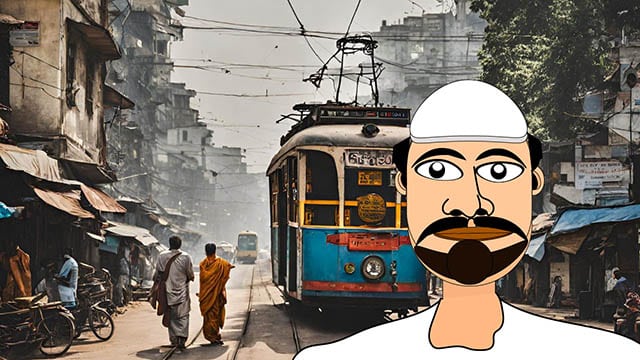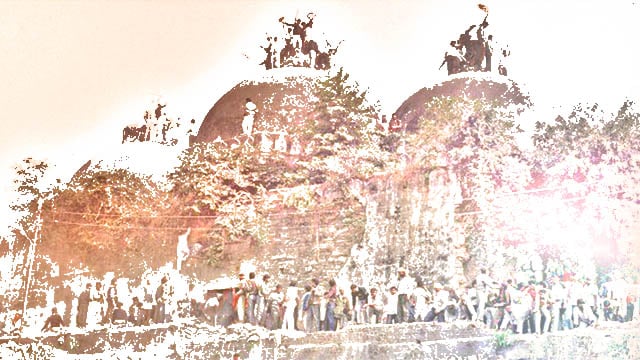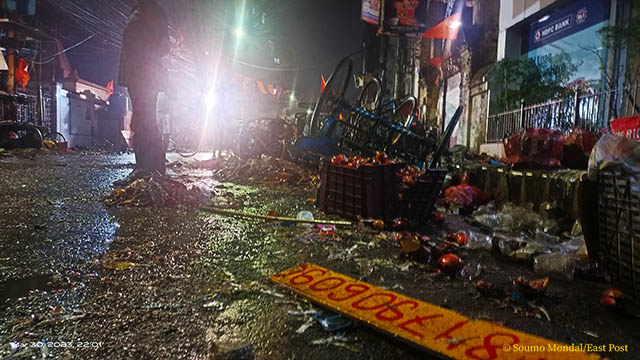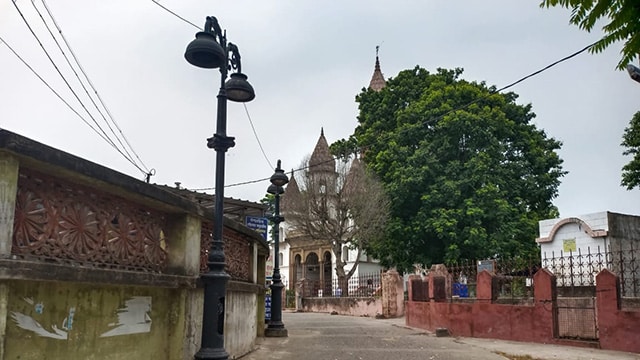Unveiling the modus operandi of Islamophobia in Kolkata, the hub of progressive culture, politics and activism in India.
Nestled in the vibrant College Street area of Kolkata, the capital of the Indian state of West Bengal, during the early 1990s, Abhijit Majumder’s childhood unfolded amid a paradoxical landscape.
While College Street still boasts illustrious educational institutions like the Presidency College (now a university), National Medical College and Calcutta University, which epitomise the academic prowess of the Bhadralok community— English-educated Bengali Hindu middle-class created and nurtured by the British colonial rulers for its clerical requirements—its demographic tapestry remains painted with stark communal divisions.
Despite being surrounded by Muslim-majority neighbourhoods, Mr Majumder found himself devoid of Muslim classmates in school—a reality reflective of the entrenched segregation prevalent in Indian cities like Kolkata.
Systemic segregation
A recent study has illuminated the extent of this segregation. It underscored a systemic denial of public services, education, and healthcare to marginalised communities, especially Muslims, who are 14% of India’s 1.4bn population, perpetuating deep-rooted inequalities along caste and religious lines.
According to the study, “Muslims are relatively more segregated in cities than in rural areas”, compared to the ostracised Dalits, who are 17% of India’s population.

The study further says that compared to a 0% Muslim locality, a 100% Muslim locality in the same city is 10% less likely to have a piped water infrastructure. Around 26% of Muslims live in areas with more than 80% Muslims.

Similarly, raising the Muslim share of a locality by 50 percentage points is associated with a 22% lower likelihood of the area having a public secondary school. Localities with more than 50% of Muslim population are particularly under-provisioned in India.


Moreover, the 17-18-year-olds living in a 100% Muslim locality have 2.1 fewer years of education than those in 0% Muslim areas.
This pervasive segregation, woven into the fabric of both rural and urban societies, serves as a fertile breeding ground for stereotypes and discrimination, fostering an atmosphere ripe for Islamophobia.
Islamophobia’s mechanism: Catch them early!
“The Muslim children experience animal slaughtering from their childhood. They see bloodshed during Muharram, so by the time they grow up, they have relatively very little compassion left in them”
For Mr Majumder, now a professor at the esteemed Indian Institute of Technology, Bombay, childhood memories are tinged with overheard conversations that painted the Muslim minority as inherently violent—a narrative echoed by extended family members.
“The Muslim children experience animal slaughtering from their childhood. They see bloodshed during Muharram, so by the time they grow up, they have relatively very little compassion left in them, this was what I heard while growing up from extended family members,” Mr Majumder said.
These anecdotes, a staple of the majority upper-caste Hindu upbringing in India, perpetuate apocryphal tales that vilify Muslims, instilling an inherent aversion towards them from childhood.
Muslim women and the attitude of Muslim men towards them, especially the practice of polygamy and “triple talaq” used to be the topics, he recalled, people discussed.
“The (Muslim) women have no freedom, so wherever else they may get married but under no circumstances can a girl of the family be allowed to marry a Muslim,” Mr Majumder recalled.
‘They will slit your throat if you marry them’
A journalism student, Indrani Chakraborty, recalls similar sentiments permeating her formative years. Forbidden from entertaining the prospect of dating a Muslim boy, she found herself ensnared in a web of prejudice spun by her family—a sentiment underscored by an ominous warning.
“After reaching teenage, when I was contemplating dating a boy, I was told to choose anyone, but a Muslim. ‘They will slit your throat if you marry them’,” Ms Chakraborty recalled what she heard from her family.
In a country, where inter-caste marriages—when a couple from different castes marry each other ignoring the social barriers—often result in a bloodbath, the marriage between a Hindu woman and a Muslim man can cause social tremors and result in pogroms.
Political instrumentation: The “Love Jihad” bogey
Prime Minister Narendra Modi’s federally ruling, far-right, Hindutva-driven Bharatiya Janata Party (BJP) considers the marriage between a Hindu woman and a Muslim man an act of “Jihad”—they call it “Love Jihad”.
The Hindutva camp—led by the BJP’s parental organisation Rashtriya Swayamsevak Sangh (RSS)—claims that Muslim men lure vulnerable Hindu girls with the intent to convert them to Islam and reduce the count of Hindus, who are 81% of India’s population.
The BJP has effectively wielded the “Love Jihad” narrative to clinch victories in numerous provincial elections across India. It holds direct governance in 11 of India’s 28 states and is a pivotal member of ruling coalitions in various other states. This strategic policy implementation has yielded substantial political dividends for the party.
Economic disparities: Oxfam’s insight into inequality
Oxfam’s India Discrimination Report 2022 shows that there was a 68% difference between Muslims and non-Muslims engaged as salaried workers in urban areas in 2019-20. In 2019-20, 15.6% of Muslims above 15 were engaged in regular jobs. The corresponding figure of non-Muslims was 23.3%, a 7.8 percentage points difference.
At the same time, while regular/salaried employees of non-Muslim communities earned Rs 20,346 (£193.27 or $244.26 at April 2024 rates) per month, Muslims earned Rs 13,672 (£129.87 or $164.14).
Furthermore, The Economic Times’s ET Intelligence Group’s analysis indicated in 2015 that Muslims constitute a mere 2.67% of top executives in the top 500 companies listed in the BSE.
From Bhilai to Kolkata: The fear of the Muslim man
While the term “Love Jihad” gained currency around 2014-15, coinciding with Mr Modi’s rise to power, the accusation of Muslim men enticing Hindu women is not a recent phenomenon. Surabhi Singh, in her mid-40s, contends that this allegation has roots in the past.
Ms Singh, hailing from an upper-caste Bengali Hindu family, spent her formative years in Bhilai, Chhattisgarh, where her father worked in the Union government’s steel plant. Despite her parents’ disdain for the Hindutva ideology and their refusal to endorse the Ram temple movement during her teenage years, Ms Singh encountered Islamophobia during her college days in the mid-1990s.
Reflecting on her experience, Ms Singh recalled conversations among girls in her class expressing reluctance to date Muslim boys due to parental disapproval. “Girls in our class used to say that they can’t date any Muslim boy as it’s something that their parents won’t approve,” Ms Singh said.
This marked her initial exposure to Islamophobia, a sentiment prevalent among her peers.
The disdain
The apprehension surrounding inter-religious relationships predominantly influences the mindset of upper-caste Hindu parents, particularly concerning their daughters. Even in a state like West Bengal, celebrated for its progressive ethos and culture, Hindu girls are often instructed to avoid interaction with Muslim boys from a young age.
“I was told not to mingle with children from ‘other’ communities who are below our religious stature”
Debjani Mukherjee, currently in her early 20s and pursuing law in Bengaluru, reminisced about her childhood encounters with prejudice. Recalling her innocent interactions at the tender age of seven or eight with a Muslim boy from her neighbourhood in Kolkata, she shared an unsettling memory.
“One day my grandfather noticed me playing with that boy and he lectured me about why I shouldn’t mingle with children from other communities, specifically referring to Muslims. I was too young to understand the purpose or significance of his lecture. When I didn’t heed his lecture and continued playing with the boy, I was told not to mingle with children from ‘other’ communities who are below our religious stature,” Ms Mukherjee said highlighting the notion of religious superiority and segregation prevalent among upper-caste Bengali Hindus.
However, the narrative of Hindu women being lured by Muslim men is not the sole foundation of Islamophobia. Another deeply entrenched aspect, rooted in the caste system, is the perception of cleanliness. This perspective has fuelled disdain towards Muslims and perpetuated discriminatory attitudes.
Ms Mukherjee recounted an incident from about 15 years ago involving one of her father’s Muslim colleagues. She vividly remembers her grandmother’s actions during this Muslim man’s visit to their house.
“My grandmother offered him tea and snacks in separate utensils; these were utensils we never used ourselves,” she explained. After his departure, those utensils were left untouched by her grandmother. Ms Mukherjee was tasked with collecting and placing them in the sink.
“She (her grandmother) made it clear that she wasn’t going to touch the utensils used by a Muslim,” Ms Mukherjee recalled. The distinct treatment towards this colleague of her father’s left a lasting impression on her, highlighting the discriminatory attitudes prevalent in the upper-caste Hindu society.
For Mr Majumder, the experience was different though.
“The first Muslim I remember coming to our house was a friend of my elder sister,” he recalled. Despite not recalling his name, Mr Majumder fondly described how this friend, who had a talent for singing, would visit their home during his sister’s college days. “We used to enjoy a lot of singing, music, and food together,” he added, emphasising the absence of any sense of segregation at his place.
Bengal’s history of anti-Muslim hatred
While many of them experienced these issues during the 1990s or the 2000s, it’s essential to recognise that Islamophobia didn’t emerge solely during the Ayodhya Ram temple movement spearheaded by the RSS in the late 1980s.
Its roots run deeper, particularly in West Bengal, which witnessed communal tensions long before. The partition of British India in 1947, resulting in the creation of West Bengal from the United Bengal province, fuelled by sheer Islamophobia of the landowning upper-caste Hindus, led to significant bloodshed, displacement, and a humanitarian crisis, setting the stage for enduring prejudices.
Kolkata (then Calcutta) witnessed the largest communal violence in the history of the country in 1946, which even forced Mahatma Gandhi to run a campaign to restore peace between Hindus and Muslims.
However, nothing worked. The hatred continued flowing, creating an environment of mistrust and enmity, even much before the BJP was founded.
Bipul Roy, a Kolkata-based retired government employee in his sixties, vividly remembers the pervasive casteist puritanism that dominated his ancestral home during his childhood in the 1960s.
Despite his grandmother’s unwavering adherence to casteist purity, Mr Roy distinctly recalls that his parents harboured no animosity towards Muslims. This became evident when he encountered the first Muslim in his life, Niyazi, a colleague of his father.
“But my first encounter with Islamophobia happened when I was nine years old,” recalled Mr Roy. He recounted a visit from one of his grandmother’s brothers, during which the discussion veered towards the Islamic practice of circumcision. As a child, the concept deeply unsettled him, sparking a sense of fear and leading to vivid nightmares that continued for days.
Mr Roy underscored that Hindus and Muslims coexisted in relative harmony in the rural regions of West Bengal during his upbringing. His father’s job, which required frequent transfers, exposed him to diverse communities and cultures. However, Mr Roy noted that the recent surge in fundamentalism on both sides is a trend that he views as a concerning development.
Leftist rule and Islamophobia
From 1977 to 2011, West Bengal was governed by a leftwing coalition called Left Front, spearheaded by the Communist Party of India (Marxist) [CPI(M)]. Despite this prolonged leftist rule, which effectively curbed large-scale communal conflicts within the state, the spectre of Islamophobia persisted, festering beneath the political surface.
The late 1990s marked a significant shift within the CPI(M), with many of its members and supporters succumbing to Islamophobic sentiments. This trend became particularly pronounced during the 2002 Gujarat pogrom
Subhadeep Gupta, now an editorial staff of a leading Bengali newspaper, vividly recalls his initial brush with Islamophobia during the peak of the left’s rule.
“It was in 1989-90, I was in standard VII or VIII at that time, when our Bengali teacher made some Islamophobic comments while talking about Hindu-Muslim issues and atrocities committed on some suspects caught in a village. He made these comments without realising what he was saying and later claimed that they were isolated incidents,” Mr Gupta, who couldn’t recollect having any Muslim classmates in his school days, recalled.
“I was born in a leftist family. My family members were left supporters. One of my uncles was a left supporter and a member of its trade union. During the 1999 Kargil War, that uncle said that Pakistan is a Muslim country and must be crushed. He also claimed during India’s cricket match with Pakistan that the latter’s defeat would make the Muslims (of India) sad,” said Arka Bhaduri, a journalist in his mid-30s.
“The late 1990s marked a significant shift within the CPI(M), with many of its members and supporters succumbing to Islamophobic sentiments. This trend became particularly pronounced during the 2002 Gujarat pogrom, where I witnessed numerous individuals within the left silently condoning the violence against Muslims,” Mr Bhaduri added.
The 2002 Gujarat anti-Muslim pogrom catapulted Mr Modi from a non-descript BJP apparatchik to that of a saviour of the ‘Hindu nation’. While Mr Modi successfully marketed the “Gujarat model”, the Left Front in West Bengal failed to erect an alternative model.
One of the reasons behind this failure could’ve been the inherent Islamophobia within the ranks of the left activists themselves.
Confronting the demon within
Despite the veneer of progressivism and secularism, the spectre of Islamophobia looms large over Bengali Hindu society. Once seen as a bulwark against communalism, the left grapples with its internal contradictions as the BJP has become the principal opposition force in West Bengal’s polity.
As the BJP capitalises on religious polarisation, the question remains: can Bengali Hindus transcend age-old prejudices to embrace their fellow Muslim citizens as equals? The answer holds the key to a future free from the bloodbaths and antagonisms of the past.
Tanmoy Ibrahim is a journalist who writes extensively on geopolitics and political economy. During his two-decade-long career, he has written extensively on the economic aspects behind the rise of the ultra-right forces and communalism in India. A life-long student of the dynamic praxis of geopolitics, he emphasises the need for a multipolar world with multilateral ties for a peaceful future for all.




